Soil Loss Estimation Using Remote Sensing and RUSLE Model in Koromi-Federe Catchment Area of Jos-East LGA, Plateau State, Nigeria
Abstract
1. Introduction
2. Materials and Methods
2.1. Study Area
2.2. Description of the RUSLE Method
2.2.1. Rainfall Erosivity Factor (R Factor)
2.2.2. Soil Erodibility (K Factor)
- K = soil erodibility factor.
- OM = organic matter content
- P = soil permeability class
- S = soil structure
- M = particle size parameter (%silt + % very fine sand) × (100 − %clay)
2.2.3. Slope Length and Slope Steepness (LS Factor)
- FA = Flow Accumulation
- m = slope value
- s = slope DEM
- cs = cell size
2.2.4. Cover Management Practices (C Factor)
2.2.5. Management Factor (P Factor)
3. Results
3.1. Rainfall Erosivity Factor (R Factor)
3.2. Soil Erodibility Factor (K Factor)
3.3. Slope Length and Slope Steepness (LS Factor)
3.4. Crop Management Factor (C Factor)
3.5. The Soil Management Practice (P Factor)
3.6. Soil Loss Analysis
3.7. Soil Loss Hazard
4. Discussion
5. Conclusions and Recommendations
Author Contributions
Funding
Acknowledgments
Conflicts of Interest
References
- Dutta, D.; Das, S.; Kundu, A.; Taj, A. Soil erosion risk assessment in Sanjal watershed, Jharkhand (India) using geo-informatics, RUSLE model and TRMM data. Model. Earth Syst. Environ. 2015, 1, 37. [Google Scholar] [CrossRef]
- Köninger, J.; Panagos, P.; Jones, A.; Briones, M.J.I.; Orgiazzi, A. In defence of soil biodiversity: Towards an inclusive protection in the European Union. Biol. Conserv. 2022, 268, 109475. [Google Scholar] [CrossRef]
- Mikula, D.; Croskey, H.M.; Lesmez, M.W. Soil Erosion. Science 1933. [Google Scholar]
- Bhattarai, R.; Dutta, D. Estimation of Soil Erosion and Sediment Yield Using GIS at Catchment Scale. Water Resour. Manag. 2007, 21, 1635–1647. [Google Scholar] [CrossRef]
- Poesen, J.; Savat, J. Detachment and transportation of loose sediments by raindrop splash: Part II Detachability and transport ability measurements. Catena 1981, 8, 19–41. [Google Scholar] [CrossRef]
- Zougmoré, R.B.; Mando, A.; Stroosnijder, L. Soil Nutrient and Sediment Loss as Affected By Erosion Barriers and Nutrient Source in Semi-Arid Burkina Faso. Arid Land Res. Manag. 2009, 23, 101–185. [Google Scholar] [CrossRef]
- Lemma, B.; Kebede, F.; Mesfin, S.; Fitiwy, I.; Abraha, Z.; Norgrove, L. Quantifying annual soil and nutrient lost by rill erosion in continuously used semiarid farmlands, North Ethiopia. Environ. Earth Sci. 2017, 76, 190. [Google Scholar] [CrossRef]
- Zhao, Q.; Li, D.; Zhuo, M.; Guo, T.; Liao, Y.; Xie, Z. Effects of rainfall intensity and slope gradient on erosion characteristics of the red soil slope. Stoch. Environ. Res. Risk Assess. 2015, 29, 609–621. [Google Scholar] [CrossRef]
- Lal, R. Soil erosion and the global carbon budget. Environ. Int. 2003, 29, 437–450. [Google Scholar] [CrossRef]
- Zhou, W.; Wu, B. Assessment of soil erosion and sediment delivery ratio using remote sensing and GIS: A case study of upstream Chaobaihe River catchment, north China. Int. J. Sediment Res. 2008, 23, 167–173. [Google Scholar] [CrossRef]
- Pimentel, D. Soil Erosion: A Food and Environmental Threat. Environ. Dev. Sustain. 2006, 8, 119–137. [Google Scholar] [CrossRef]
- Chinnasamy, P.; Honap, V.U.; Maske, A.B. Impact of 2018 Kerala Floods on Soil Erosion: Need for Post-Disaster Soil Management. J. Indian Soc. Remote Sens. 2020, 48, 1373–1388. [Google Scholar] [CrossRef]
- Chen, L.; Yan, Z.; Li, Q.; Xu, Y. Flash Flood Risk Assessment and Driving Factors: A Case Study of the Yantanxi River Basin, Southeastern China. Int. J. Disaster Risk Sci. 2022, 13, 291–304. [Google Scholar] [CrossRef]
- Chalise, D.; Kumar, L.; Kristiansen, P. Land Degradation by Soil Erosion in Nepal: A Review. Soil Syst. 2019, 3, 12. [Google Scholar] [CrossRef]
- Lal, R. Soil Erosion and Land Degradation: The Global Risks. In Advances in Soil Science: Soil Degradation Volume 11; Lal, R., Stewart, B.A., Eds.; Springer: New York, NY, USA, 1990; pp. 129–172. [Google Scholar]
- Eswaran, H.; Lal, R.; Reich, P. Land degradation: An overview. In Response to Land Degradation, 1st ed.; Taylor & Francis Group: Oxfordshire, UK, 2019; pp. 20–35. [Google Scholar]
- IPCC. Climate Change 2013: The Physical Science Basis. Contribution of Working Group I to the Fifth Assessment Report of the Intergovernmental Panel on Climate Change; Cambridge University Press: Cambridge, UK; New York, NY, USA, 2013; p. 1535. [Google Scholar]
- Chinda, P.A.; Danladi, T.E. Evidence of Climate Change on Derived Precipitation Effectiveness Indices and Anomalous Precipitaion Pattern of Jos South Local Government Area of Plateau State, Nigeria. Int. J. Latest Technol. Eng. Manag. Appl. Sci. 2019, 8, 83–95. [Google Scholar]
- Group, W.B. Nigeria—Erosion and Watershed Management Project (English); World Bank: Washington, DC, USA, 2012. [Google Scholar]
- Ahmari, H.; Pebworth, M.; Baharvand, S.; Kandel, S.; Yu, X. Development of an ArcGIS-Pro Toolkit for Assessing the Effects of Bridge Construction on Overland Soil Erosion. Land 2022, 11, 1586. [Google Scholar] [CrossRef]
- Stefanidis, S.; Chatzichristaki, C.; Stefanidis, P. An ArcGIS toolbox for estimation and mapping soil erosion. J. Environ. Prot. Ecol. 2021, 22, 689–696. [Google Scholar]
- Mhangara, P.; Kakembo, V.; Lim, K.J. Soil erosion risk assessment of the Keiskamma catchment, South Africa using GIS and remote sensing. Environ. Earth Sci. 2012, 65, 2087–2102. [Google Scholar] [CrossRef]
- Routschek, A.; Schmidt, J.; Kreienkamp, F. Climate Change Impacts on Soil Erosion: A High-Resolution Projection on Catchment Scale Until 2100. In Engineering Geology for Society and Territory—Volume 1; Springer: Cham, Switzerland, 2015; pp. 135–141. [Google Scholar]
- Onori, F.; De Bonis, P.; Grauso, S.; ENEA, Italian National Agency for New Technologies, Energy and the Environment, Environmental Protection and Technologies Division. Soil erosion prediction at the basin scale using the revised universal soil loss equation (RUSLE) in a catchment of Sicily (southern Italy). Environ. Geol. 2006, 50, 1129–1140. [Google Scholar] [CrossRef]
- Markose, V.J.; Jayappa, K.S. Soil loss estimation and prioritization of sub-watersheds of Kali River basin, Karnataka, India, using RUSLE and GIS. Environ. Monit. Assess. 2016, 188, 225. [Google Scholar] [CrossRef]
- Biswas, S.S.; Pani, P. Estimation of soil erosion using RUSLE and GIS techniques: A case study of Barakar River basin, Jharkhand, India. Model. Earth Syst. Environ. 2015, 1, 42. [Google Scholar] [CrossRef]
- Chen, T.; Niu, R.-Q.; Li, P.-X.; Zhang, L.-P.; Du, B. Regional soil erosion risk mapping using RUSLE, GIS, and remote sensing: A case study in Miyun Watershed, North China. Environ. Earth Sci. 2011, 63, 533–541. [Google Scholar] [CrossRef]
- Gashaw, T.; Tulu, T.; Argaw, M. Erosion risk assessment for prioritization of conservation measures in Geleda watershed, Blue Nile basin, Ethiopia. Environ. Syst. Res. 2017, 6, 1. [Google Scholar] [CrossRef]
- Gobin, A.M.; Campling, P.; Deckers, J.A.; Poesen, J.; Feyen, J. Soil erosion assessment at the Udi-Nsukka Cuesta (southeastern Nigeria). Land Degrad. Dev. 1999, 10, 141–160. [Google Scholar] [CrossRef]
- Adediji, A.; Tukur, A.; Adepoju, K. Assessment of revised universal soil loss equation (RUSLE) in Katsina area, Katsina state of Nigeria using remote sensing (RS) and geographic information system (GIS). Iran. (Iran.) J. Energy Environ. 2010, 1, 255–264. [Google Scholar]
- Adeola Fashae, O.; Abiola Ayorinde, H.; Oludapo Olusola, A.; Oluseyi Obateru, R. Landuse and surface water quality in an emerging urban city. Appl. Water Sci. 2019, 9, 25. [Google Scholar] [CrossRef]
- Merritt, W.S.; Letcher, R.A.; Jakeman, A.J. A review of erosion and sediment transport models. Environ. Model. Softw. 2003, 18, 761–799. [Google Scholar] [CrossRef]
- Wischmeier, W.H.; Smith, D.D. Predicting Rainfall Erosion Losses: A Guide to Conservation Planning; US Department of Agriculture, Science and Education Administration: Washington, DC, USA, 1978; Handbook No. 537.
- Renard, K.; Foster, G.; Weesies, G.; McCool, D.; Yoder, D. Predicting soil erosion by water: A guide to conservation planning with the Revised Universal Soil Loss Equation (RUSLE). In Agriculture Handbook; United States Government Printing: Washington, DC, USA, 1996; Volume 703. [Google Scholar]
- Laflen, J.M.; Lane, L.J.; Foster, G.R. WEPP: A new generation of erosion prediction technology. J. Soil Water Conserv. 1991, 46, 34–38. [Google Scholar]
- Flanagan, D.C.; Ascough, J.C.; Nearing, M.A.; Laflen, J.M. The Water Erosion Prediction Project (WEPP) Model. In Landscape Erosion and Evolution Modeling; Harmon, R.S., Doe, W.W., Eds.; Springer: Boston, MA, USA, 2001; pp. 145–199. [Google Scholar]
- Clark, K. An estimate of sediment yield for two small sub-catchment in a geographic information system. Ph.D. Thesis, University of New Mexico, Albuquerque, NM, USA, 2001. [Google Scholar]
- Daneshvar, M.R.M.; Bagherzadeh, A. Evaluation of sediment yield in PSIAC and MPSIAC models by using GIS at Toroq Watershed, Northeast of Iran. Front. Earth Sci. 2012, 6, 83–94. [Google Scholar] [CrossRef]
- Tangestani, M.H. Comparison of EPM and PSIAC models in GIS for erosion and sediment yield assessment in a semi-arid environment: Afzar Catchment, Fars Province, Iran. J. Asian Earth Sci. 2006, 27, 585–597. [Google Scholar] [CrossRef]
- Bayramin, I.; Dengiz, O.; BAŞKAN, O.; Parlak, M. Soil erosion risk assessment with ICONA model; case study: Beypazarı area. Turk. J. Agric. For. 2003, 27, 105–116. [Google Scholar]
- Amiri, F. Estimate of erosion and sedimentation in semi-arid basin using empirical models of erosion potential within a geographic information system. Air Soil Water Res. 2010, 3, ASWR-S3427. [Google Scholar] [CrossRef]
- Rafahi, H.; Namati, M. Using EPM for study erodibility and sediment yield in Alamout watershed. Iran. J. Agric. Sci. 1994, 26, 32–45. [Google Scholar]
- Eisazadeh, L.; Sokouti, R.; Homaee, M.; Pazira, E. Comparison of empirical models to estimate soil erosion and sediment yield in micro catchments. Eurasian J. Soil Sci. 2012, 1, 28–33. [Google Scholar]
- FIÇICI, M.; SOYKAN, A. MPSIAC & RUSLE Yöntemleriyle Karşılaştırmalı Erozyon Analizi: Madra Barajı Havzası. Jeomorfol. Araştırmalar Derg. 2022, 8, 28–47. [Google Scholar]
- Millward, A.A.; Mersey, J.E. Adapting the RUSLE to model soil erosion potential in a mountainous tropical watershed. Catena 1999, 38, 109–129. [Google Scholar] [CrossRef]
- Ghosal, K.; Das Bhattacharya, S. A Review of RUSLE Model. J. Indian Soc. Remote Sens. 2020, 48, 689–707. [Google Scholar] [CrossRef]
- Obiahu, O.H.; Elias, E. Effect of land use land cover changes on the rate of soil erosion in the Upper Eyiohia river catchment of Afikpo North Area, Nigeria. Environ. Chall. 2020, 1, 100002. [Google Scholar] [CrossRef]
- Islam, Z. Soil loss assessment by RUSLE in the cloud-based platform (GEE) in Nigeria. Model. Earth Syst. Environ. 2022, 8, 4579–4591. [Google Scholar] [CrossRef]
- Okenmuo, F.C.; Ewemoje, T.A. Estimation of soil water erosion using RUSLE, GIS, and remote sensing in Obibia River watershed, Anambra, Nigeria. DYSONA-Appl. Sci. 2022, 4, 6–14. [Google Scholar]
- Dike, B.; Alakwem, O.; Nwoke, H.; Nwakwasi, N. Potential Soil Loss Rates in Urualla, Nigeria using Rusle. Glob. J. Sci. Front. Res. Environ. Earth Sci. 2018, 18, 43–48. [Google Scholar]
- Emeribeole, A.; Iheaturu, C. Mapping of potential soil erosion risk areas in Imo State using the Revised Universal Soil Loss Equation (RUSLE). Remote Sens. (RS) Geospat. Inf. Syst. (GIS) Tech. (10) 2015, 2, 36–44. [Google Scholar]
- Ibrahim, E.S.; Rufin, P.; Nill, L.; Kamali, B.; Nendel, C.; Hostert, P. Mapping crop types and cropping systems in nigeria with sentinel-2 imagery. Remote Sens. 2021, 13, 3523. [Google Scholar] [CrossRef]
- Ibrahim, E.S.; Gajere, E.N.; Dang, B.A.; Jerome, I.; Dashan, T.; Mwada, H.; Ojih, S. Geospatial Tools for Suitable Assessment of Small Holder Irrigation Water, towards Increased Food Production and Poverty Eradication in Nigeria: A Case of Jos East LGA. Plateau State. J. Remote Sens GIS 2020, 9, 274. [Google Scholar] [CrossRef]
- Hadas, A. Soil and water conservation engineering: G.D. Schwab, D.D. Fangmeier, W.J. Elliot and R.K. Frevert, 1993. J. Wiley and Sons, Inc., New York, 1993, 4th Edition, 507 pp., £57.00 (clothbound), £ 16.95 (paperback). ISBN 0-471-59994-8, S623. S572, 63.4 dc. Soil Tillage Res. 1994, 32, 88–89. [Google Scholar] [CrossRef]
- Kinnell, P.I.A. Event soil loss, runoff and the Universal Soil Loss Equation family of models: A review. J. Hydrol. 2010, 385, 384–397. [Google Scholar] [CrossRef]
- Erbek, F.S.; Özkan, C.; Taberner, M. Comparison of maximum likelihood classification method with supervised artificial neural network algorithms for land use activities. Int. J. Remote Sens. 2004, 25, 1733–1748. [Google Scholar] [CrossRef]
- Olofsson, P.; Foody, G.M.; Herold, M.; Stehman, S.V.; Woodcock, C.E.; Wulder, M.A. Good practices for estimating area and assessing accuracy of land change. Remote Sens. Environ. 2014, 148, 42–57. [Google Scholar] [CrossRef]
- Kelly-Hope, L.A.; Hemingway, J.; McKenzie, F.E. Environmental factors associated with the malaria vectors Anopheles gambiae and Anopheles funestus in Kenya. Malar. J. 2009, 8, 268. [Google Scholar] [CrossRef]
- Hilborn, D.; Stone, R.P. Determining the Phosphorus Index for a Field; Ministry of Agriculture, Food & Rural Affairs: Guelph, ON, Canada, 1998.
- Benkobi, L.; Trlica, M.J.; Smith, J.L. Evaluation of a refined surface cover subfactor for use in RUSLE. J. Range Manag. 1994, 47, 74–78. [Google Scholar] [CrossRef]
- Langbein, W.B.; Schumm, S.A. Yield of sediment in relation to mean annual precipitation. EOS Trans. Am. Geophys. Union 1958, 39, 1076–1084. [Google Scholar] [CrossRef]
- Srivastava, A.; Yetemen, O.; Saco, P.M.; Rodriguez, J.F.; Kumari, N.; Chun, K.P. Influence of orographic precipitation on coevolving landforms and vegetation in semi-arid ecosystems. Earth Surf. Process. Landf. 2022, 47, 2846–2862. [Google Scholar] [CrossRef]



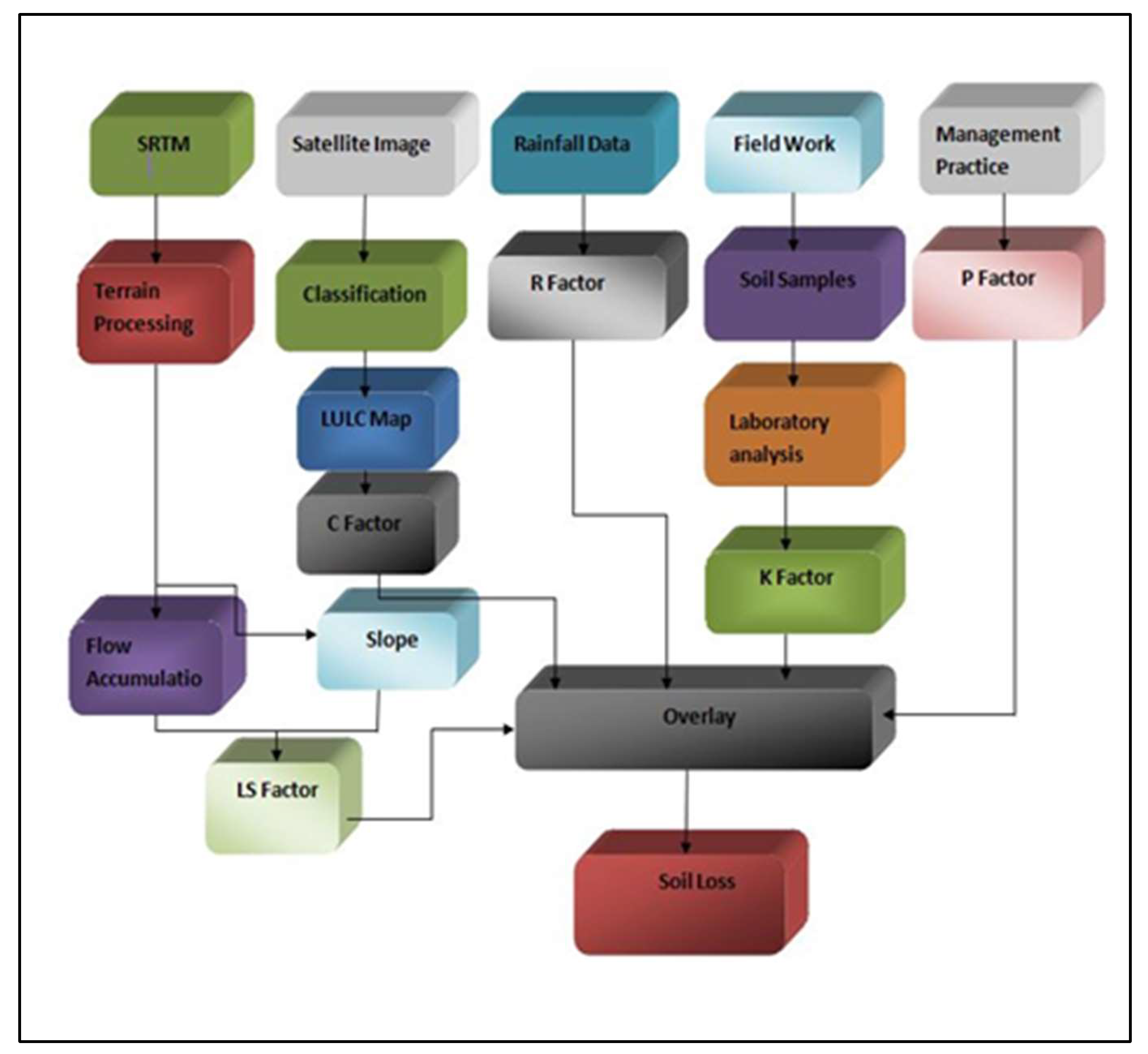
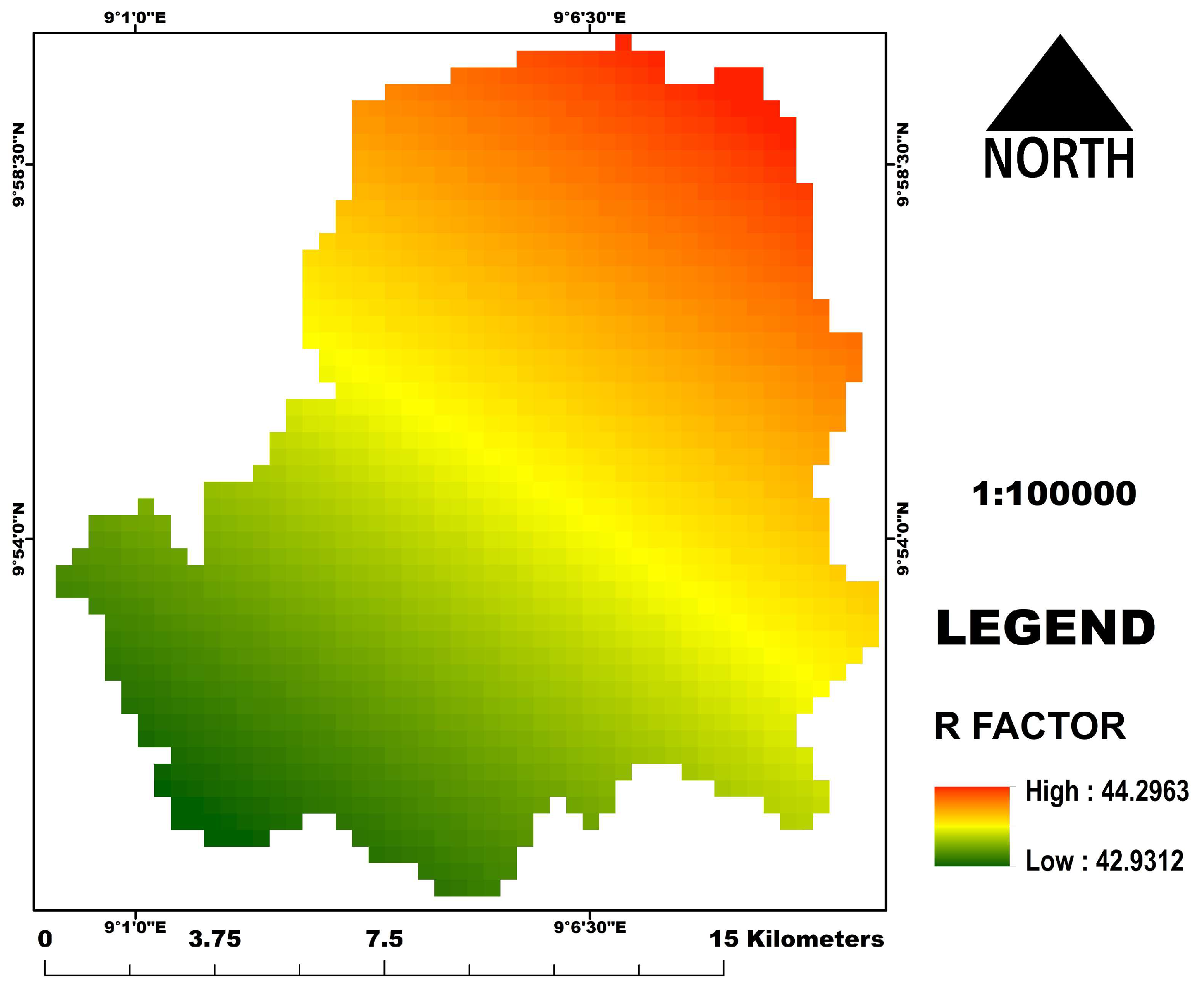



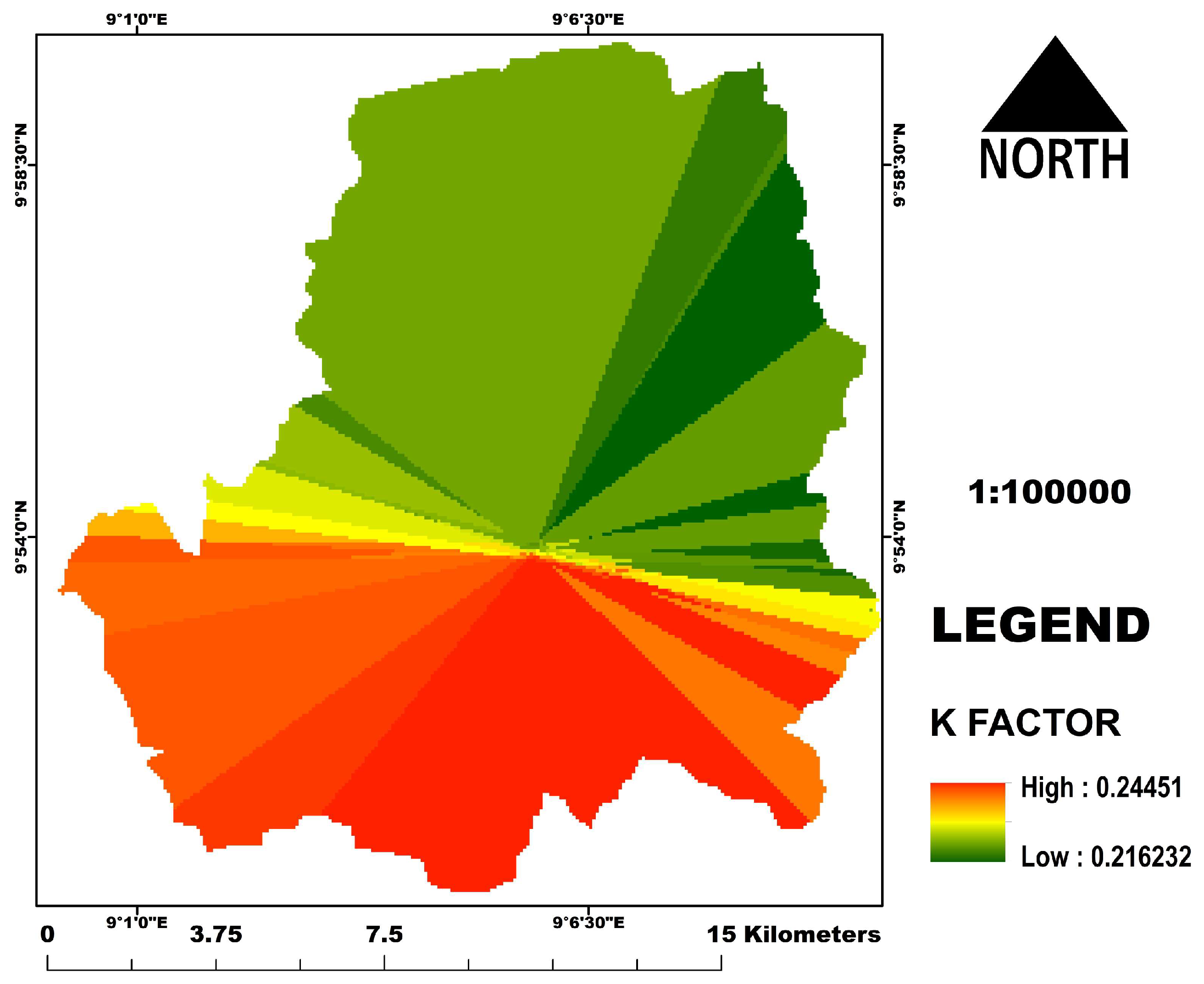
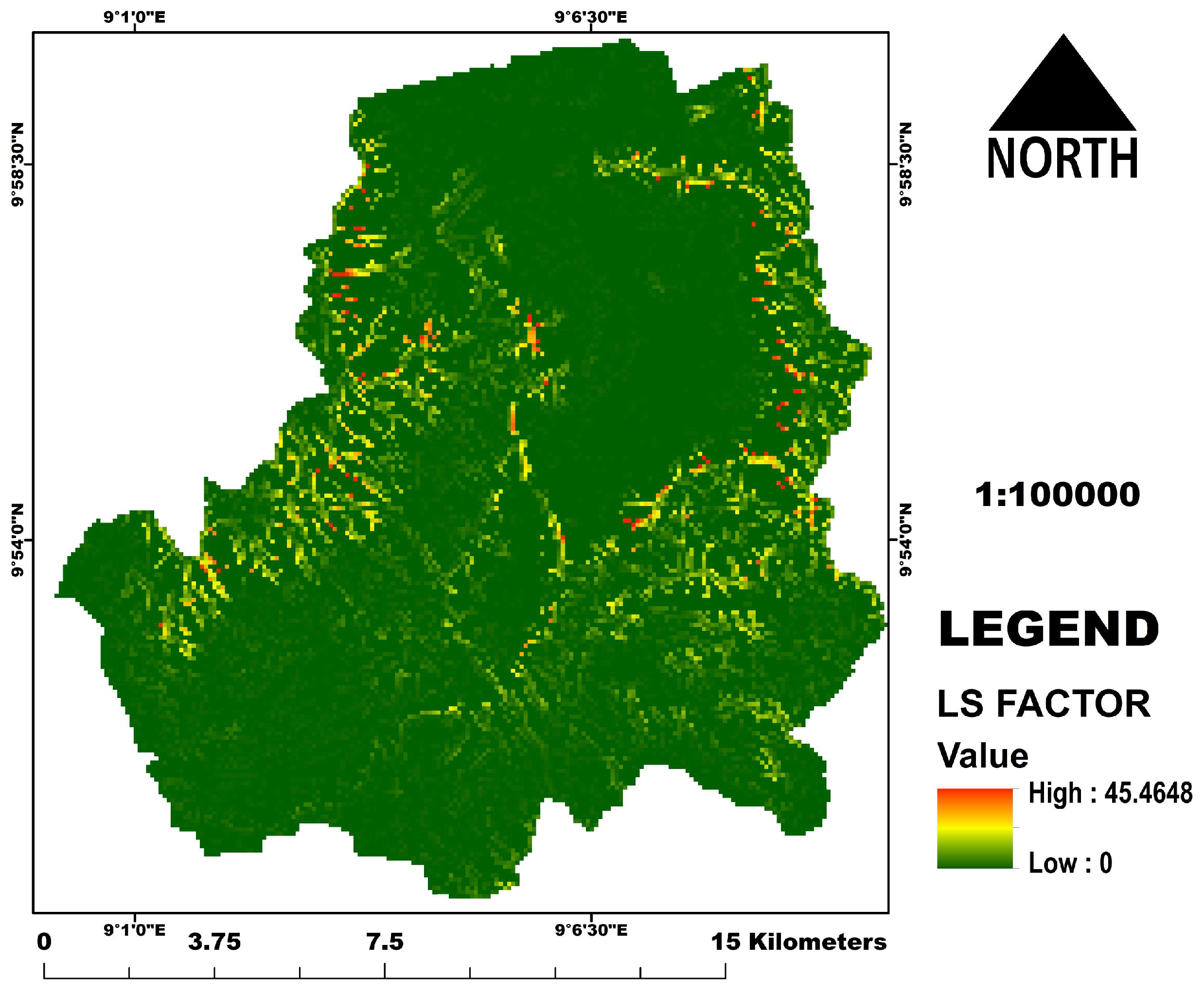
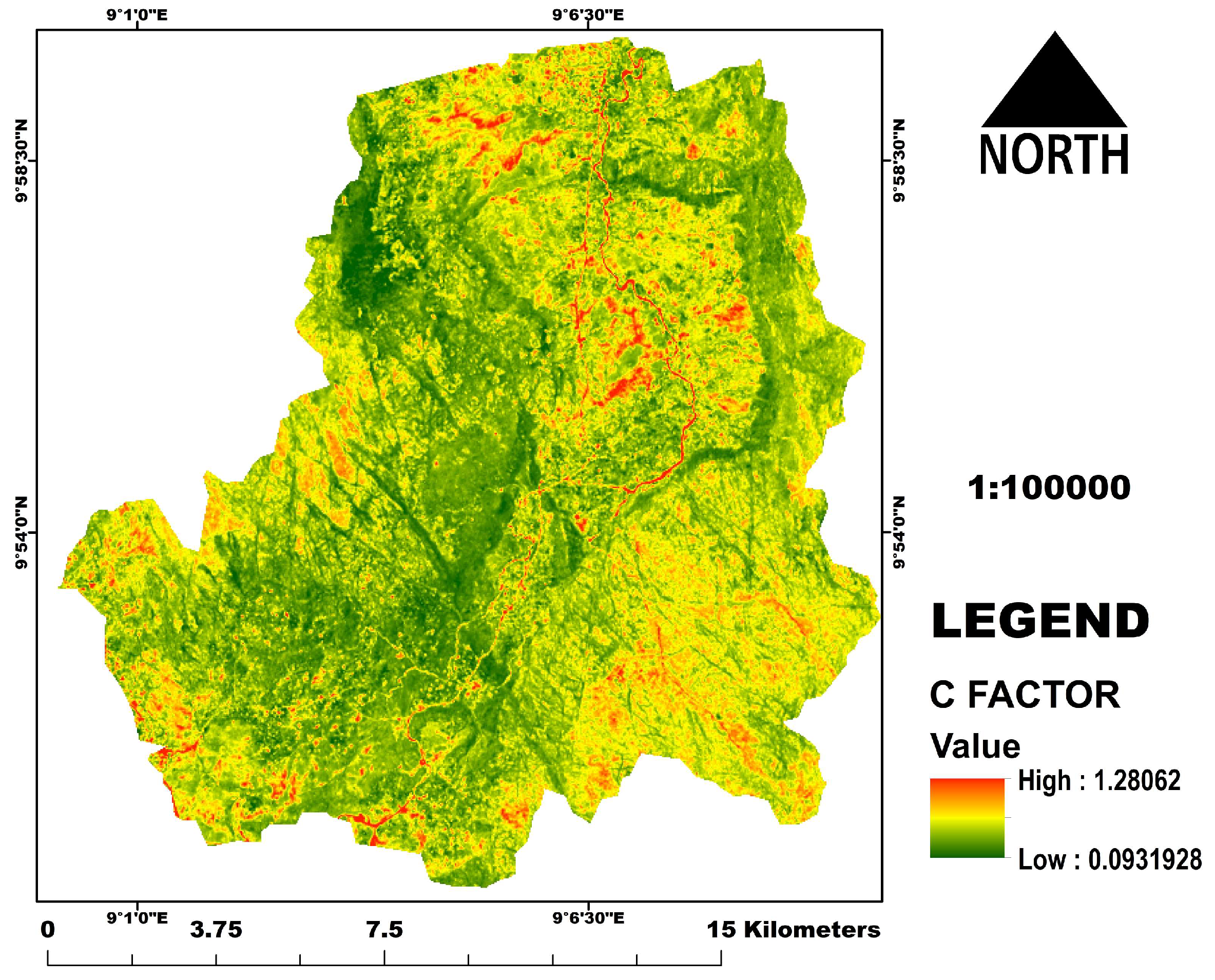
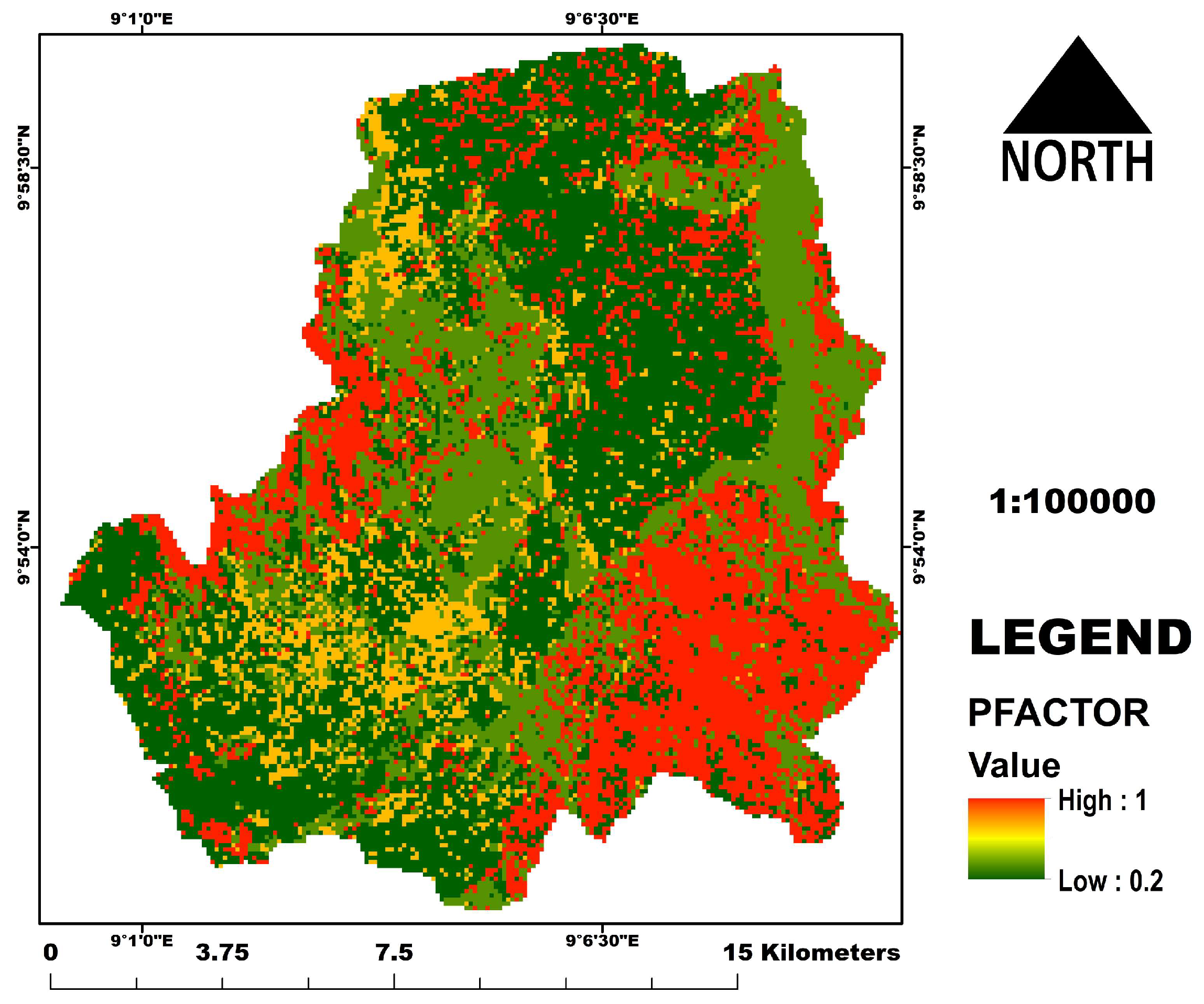

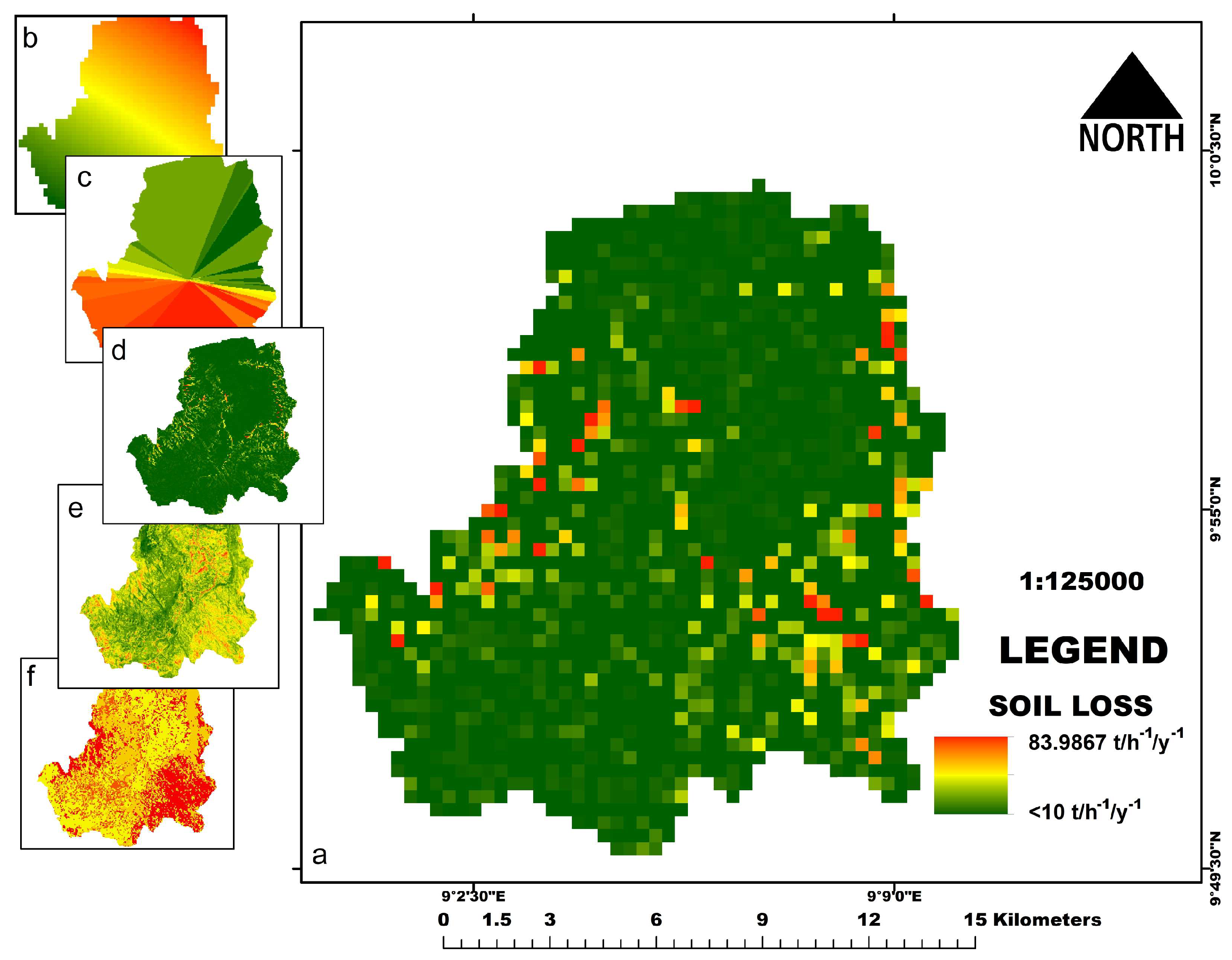
| Data | Type | Spatial Resolution | Source |
|---|---|---|---|
| Rainfall | Vector | - | NIMET |
| Soil | Vector | - | Field work |
| Elevation and slope (derived from SRTM) | Raster | 30 m | https://earthexplorer.usgs.gov/ accessed on 15 February 2016 |
| Land cover and NDVI (derived from Landsat 8, dated 16 October 2015). | Raster | 30 m | https://earthexplorer.usgs.gov/ accessed on 15 February 2016 |
| Rate of Loss | Soil Loss (t/h−1/y−1) | Percentage (%) |
|---|---|---|
| Tolerable/negligible | <10 | 95.27 |
| Low loss | 10–20 | 3.57 |
| Moderate loss | 20–50 | 1.03 |
| Critical loss | >50 | 0.12 |
Publisher’s Note: MDPI stays neutral with regard to jurisdictional claims in published maps and institutional affiliations. |
© 2022 by the authors. Licensee MDPI, Basel, Switzerland. This article is an open access article distributed under the terms and conditions of the Creative Commons Attribution (CC BY) license (https://creativecommons.org/licenses/by/4.0/).
Share and Cite
Ugese, A.A.; Ajiboye, J.O.; Ibrahim, E.S.; Gajere, E.N.; Itse, A.; Shaba, H.A. Soil Loss Estimation Using Remote Sensing and RUSLE Model in Koromi-Federe Catchment Area of Jos-East LGA, Plateau State, Nigeria. Geomatics 2022, 2, 499-517. https://doi.org/10.3390/geomatics2040027
Ugese AA, Ajiboye JO, Ibrahim ES, Gajere EN, Itse A, Shaba HA. Soil Loss Estimation Using Remote Sensing and RUSLE Model in Koromi-Federe Catchment Area of Jos-East LGA, Plateau State, Nigeria. Geomatics. 2022; 2(4):499-517. https://doi.org/10.3390/geomatics2040027
Chicago/Turabian StyleUgese, Andrew Ayangeaor, Jesugbemi Olaoye Ajiboye, Esther Shupel Ibrahim, Efron Nduke Gajere, Atang Itse, and Halilu Ahmad Shaba. 2022. "Soil Loss Estimation Using Remote Sensing and RUSLE Model in Koromi-Federe Catchment Area of Jos-East LGA, Plateau State, Nigeria" Geomatics 2, no. 4: 499-517. https://doi.org/10.3390/geomatics2040027
APA StyleUgese, A. A., Ajiboye, J. O., Ibrahim, E. S., Gajere, E. N., Itse, A., & Shaba, H. A. (2022). Soil Loss Estimation Using Remote Sensing and RUSLE Model in Koromi-Federe Catchment Area of Jos-East LGA, Plateau State, Nigeria. Geomatics, 2(4), 499-517. https://doi.org/10.3390/geomatics2040027






